Raise a flagon of hearty mead for three new reviewers here in Thor’s Comic Column: Russell Paulette, Rob Glenn and Graig Kent.
Now, to the reviews, verily!
First Look: Joss Whedon is Well on His Way Toward Putting Together One of the Better “X-Men” Runs
By Devon Sanders
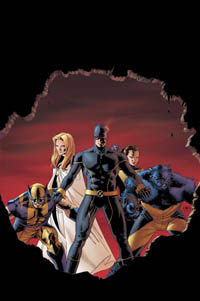 Wednesdays have been an absolute joy for me over the past eight years. On those Wednesdays, I’ve made many friends of people because of one simple thing: the comic book. Nothing brings out the extrovert in the mousy like a good (or very bad) comic. Ask tried and true Spider-Man fans about the infamous “Clone Saga” and watch the heated debate this story will bring about. From debates like this, I’ve been able to decide who to embrace and who to keep at arm’s length. Over the past six months, I’ve been embracing many a reader, new and old, with Joss Whedon and John Cassaday’s Astonishing X-Men run. For many, it’s the greatest thing since…well, Chris Claremont and John Byrne’s run on Uncanny X-Men. For myself, it reminds me of the spark these characters have if creators treat them as something more than another assignment. This Wednesday, Whedon and Cassaday bring you Astonishing X-Men # 7, confirming my belief that 22 pages of words and art, pound for pound, is still some of the best entertainment around.
Wednesdays have been an absolute joy for me over the past eight years. On those Wednesdays, I’ve made many friends of people because of one simple thing: the comic book. Nothing brings out the extrovert in the mousy like a good (or very bad) comic. Ask tried and true Spider-Man fans about the infamous “Clone Saga” and watch the heated debate this story will bring about. From debates like this, I’ve been able to decide who to embrace and who to keep at arm’s length. Over the past six months, I’ve been embracing many a reader, new and old, with Joss Whedon and John Cassaday’s Astonishing X-Men run. For many, it’s the greatest thing since…well, Chris Claremont and John Byrne’s run on Uncanny X-Men. For myself, it reminds me of the spark these characters have if creators treat them as something more than another assignment. This Wednesday, Whedon and Cassaday bring you Astonishing X-Men # 7, confirming my belief that 22 pages of words and art, pound for pound, is still some of the best entertainment around.
A statement needs to be made. A big, loud statement. With resident strongman, Colossus, surfing atop The Blackbird, The Astonishing X-Men fly into
Writer Joss (Buffy the Vampire Slayer) Whedon’s run on Astonishing X-Men has been nothing but a love letter to The X-Men’s mid-Seventies/early Eighties glory days. Whedon’s X-Men are portrayed as friends, allies and enemies, everything thirty years of interaction should bring. It is a joy to read this man’s words, as not one is ever wasted. There’re no red herrings to obstruct from the sheer power of seeing these characters working together to astonish, thirty years on. On page 9, with four simple words, he lets us get as close to
Brilliant writing is coupled with John (Captain
Astonishing X-Men # 7 simply reaffirms my love for comics. It’s a comic that I want to pass on to friends. If someone asks me why I love comics, besides 100 Bullets, Astonishing X-Men is the comic that will speak for me. This is the type of comic that makes Wednesdays worthwhile. Astonishing X-Men # 7 is highly recommended.
FOUR OUT OF FIVE VIKINGS

The Wachowski Brothers Launch Their New Comic Line With Monstrous Beginnings
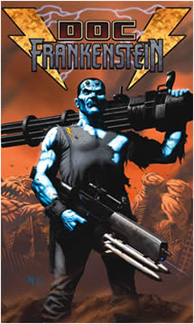 The Wachowski brothers, creators of The Matrix.
The Wachowski brothers, creators of The Matrix.
That probably got your attention. Now that they’ve got all that Neo business out of their systems, The Matrix masterminds Andy and Larry Wachowski are back in the industry in which they toiled before helping make wire-fu and bullet-time the most imitated cinematic elements since a shiny metallic guy morphed into Robert Patrick. Teaming with their cohorts, noted comic book and Matrix storyboard/concept artists Steve Skroce and Geoff Darrow, the Wachowskis have launched Burlyman Entertainment, kicking it off with Doc Frankenstein.
Set in some alternate now, their take on Mary Shelley’s legendary character opens with the blue-skinned product of reanimation having just dispatched a massive kaiju-style beast in front of the White House. From there we learn pieces of the patchwork man’s past through flashbacks, covering his creation at the hands of his “father”, his rescue of an Eskimo girl from a rampaging Yeti, and his time in the Old West as a brutal bounty hunter. In the present (as it were), Frankenstein returns to his home in the middle of the desert, a massive utopian metropolis which immediately comes under attack by an air fleet of heavily-armed religious types.
The series doesn’t waste words dropping readers into its world, but this is somewhat to its detriment – I have little idea how Frankenstein (yes, that’s what he calls himself), came to be an unwelcome champion in a world of incongruously advanced science, or why the squadron of Bible-thumping paramilitary zealots wants to wipe him and the citizens of his city off the planet. It’s not enigmatic to the point of frustration, but a little more exposition would’ve been appreciated. Then again, this is the Wachowski brothers, whose idea of elucidation is a bearded man with a roomful of televisions and a thesaurus in his brain, so distended dialogue such as “I am a cesarean inflicted upon the womb of your reality” doesn’t actually come as much of a surprise coming from the mouth of their crafty hand-crafted protagonist.
Also unsurprising is Steve Skroce’s exceptional artwork, dynamic without being overstylized, and the cover (painted by cover artist extraordinaire Kaare Andrews) is fantastic as well. I really like Skroce’s depiction of the Old West – this all-too-brief segment of the story is my favorite, and I hope the creative team revisits the period in future issues. So far I’m not entirely fascinated by Doc Frankenstein, but definitely intrigued.
THREE AND A HALF OUT OF FIVE VIKINGS

Rorschach Entertainment’s “Grave Digger” is a Hardboiled Heist Flick on Paper – So, of Course I Like It
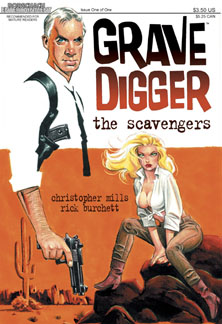 While reading Grave Digger, a recent stand-alone tale of crime fiction, I couldn’t help but be reminded of 2003’s The Last of the Independents. Both are small press titles about a heist gone sour in the American southwest. Both center on an experienced and weathered professional criminal looking for that last score to retire on, and both are told in the best pulp and gritty tradition of Jim Thompson. But where The Last of the Independents is very much about an honorable old thief with a moral center, Grave Digger is about a real stone-cold son of a bitch. This is a good tale about a bad man.
While reading Grave Digger, a recent stand-alone tale of crime fiction, I couldn’t help but be reminded of 2003’s The Last of the Independents. Both are small press titles about a heist gone sour in the American southwest. Both center on an experienced and weathered professional criminal looking for that last score to retire on, and both are told in the best pulp and gritty tradition of Jim Thompson. But where The Last of the Independents is very much about an honorable old thief with a moral center, Grave Digger is about a real stone-cold son of a bitch. This is a good tale about a bad man.
These days it’s so hard to write completely original crime fiction, and to be perfectly honest – like most heist stories – much of Grave Digger revolves around guessing where the next double-cross will come from. That said, writer Christopher Mills is still able to keep you on your toes with the twists, turns, hidden motives and secret agendas. It may be slightly cliché, but damn if it isn’t well executed. I was genuinely surprised when everything finally unfolded.
Given then the difficulty of “knocking ‘em dead” with the plot, the real markers for good crime fiction are the characters, the dialogue and the atmosphere – which Grave Digger has in spades. Recently released from prison, but still on top of his game, Digger McRae really is a bad guy to root for. He looks exactly like Lee Marvin (courtesy of the exceptionally talented Rick Burchett) and carries with him Marvin’s classic tough-guy swagger. In charge. Doesn’t take any crap. Always thinking about the angles and an ace with the ladies…even if it is an another man’s wife. He’s a hard character not to like and a perfect mouthpiece for Mills to deliver some classic pulp dialogue. A gritty but hip first person narrative.
One of the things that is unique about Grave Digger is the visual presentation – a widescreen format if you will that lends itself to the cinematic feel of the story. Ultimately, that’s what this book is, a heist flick on paper – and artist Rick Burchett does an incredible job creating the requisite noir sensibility, using shadow for effect, communicating information visually, and drawing one swell looking babe. I was also impressed with Burchett’s skillful rendering of the book’s frenetic action sequences, and am looking forward to his upcoming collaboration with Greg Rucka on Queen & Country: Declassified.
All in all, Grave Digger is a swell little crime fiction vignette – a tight package. Highly recommended.
FOUR OUT OF FIVE VIKINGS

The Ending of “Identity Crisis” Could Not Possibly Meet Expectations
 Reviewing Identity Crisis # 7 is like reviewing the last twenty minutes of The Sixth Sense. You can go either of two ways: you can write to the audience that already knows the ending, or you can write to the audience that does not. At the same time, one would logically have to assume that those who read issue number seven have read issue numbers one through six… in the same way that someone who’s seen the last twenty minutes of The Sixth Sense likely would have sat through the first eighty.
Reviewing Identity Crisis # 7 is like reviewing the last twenty minutes of The Sixth Sense. You can go either of two ways: you can write to the audience that already knows the ending, or you can write to the audience that does not. At the same time, one would logically have to assume that those who read issue number seven have read issue numbers one through six… in the same way that someone who’s seen the last twenty minutes of The Sixth Sense likely would have sat through the first eighty.
That said, my first and honest reaction was: “That’s it?”
I’m sure many others had the same reaction. It’s something that resembles disappointment, and perhaps in some factions, outrage. But reread it, and actually think about it this time. Think about what it means to the rest of the series. What’s the overall story?
A minor spoiler… the mini-series does not end with a furious action sequence. It’s thirty pages of talking heads. You do get the answer to who the murderer is and you get an ending, but what you don’t get, and what the characters don’t get, is catharsis. There’s no relief for the pent up anger, frustration, fright and emotion invested in the murder of Sue Dibny (amongst others). There’s no big punch-up for the characters to let it all out, no big battle for the reader to vicariously get revenge. No, the release in this final issue is purely mental – talking and thinking, living and dealing with everything that happened, and what it says about the nature of humans, super or not.
The series brought many issues to the fore about what being a costumed hero involves – what having two lives can do to those people that live with each of you alter egos. It cast the world’s greatest heroes into a new light – or cast new shadows, it seems – imbuing them with a new level of humanity en masse, proving gods both vulnerable and relatable. Brad Meltzer shrouded this diatribe on the (super)human condition in a noir-ish murder-mystery. It’s this mystery that is Meltzer’s greatest success on Identity Crisis, and yet this is also where he failed. How could he not?
A mystery story is a difficult thing to pull off in any medium, but toss one (especially a good one) into a scrutinized genre like superhero comics, then toss the hype machine behind it, stretch that all out over seven months and expectations are going to be almost impossible to meet. Then you have the fact that comic books are published far enough in advance that really the secret under wraps until release day is going to be impossible. Even with disinformation floating out there, the real answer will hit a rumor mill somewhere and people just aren’t going to be surprised… “Oh, it’s that ending.”
But in execution, in some respects, the resolution of the mystery felt forced. I can’t tell if Meltzer had Sue’s killer pegged from the get-go or if he had a side list of possible killers. The murder does fit the murderer, and the murderer does fit the story, but the explanation delves into Murder She Wrote territory with some of the elements feeling a tad excessive for the type of crime it was and out of character for the B-lister who did it.
The series looked at the less notorious heroes and villains with a seriousness usually left for Batman or Superman. Meltzer actually made us care about some sideliners who would be easily disposed without any fanfare during another mega-event. Melzer also piqued curiosities in a host of small asides, Maguffins, if you will. However, I’m more than a little sad that I don’t get immediate answers to questions I have about, say, Luthor’s armour and Boomerang’s son. What’s more, DC did nothing to guide you where to find those answers.
In the end, like those that waited for The Sixth Sense to come out on video, those that are waiting until now to read the entire series are going to get a case of the “what’s the fuss?” But it’s a solid story with what should prove to be a lasting effect on the way some characters’ stories are told should certain writers grab the baton and run with it.
Is it earth-shattering? Is it the new Crisis? Nah. But seeing as I’ve read and reread all of the issues at least three times it’s certainly something much more than disposable.
Identity Crisis # 7 –
THREE OUT OF FIVE VIKINGS

Identity Crisis (entire miniseries)
FOUR OUT OF FIVE VIKINGS

Latest “Human Target” is a Great Place to Jump on Board
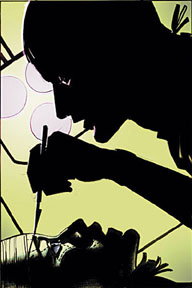 Christopher Chance is the guy you call when someone wants you dead. He steps in and you step out. He takes on your looks, your mannerisms… your life. Then he flushes out your killer and solves your problem. It’s a simple premise. Simple premises are the ones that have the most possibilities. Issue #17 of Human Target is a change of pace for Chance. Normally he’s the one who becomes someone new. This time his customer is a woman. So Chance’s task is to teach someone else his craft: how to become someone you’re not to the point where even you almost believe. It shouldn’t be too much of a stretch for Maggie. She was born Maggie Stains and then married into organized crime and became Maggie Lyons. Then she turned over state’s evidence on her husband and went into the witness protection program and became Patricia Jones. Unfortunately, her husband’s goons keep finding her. Even from prison Raymond Lyons can get at her. So she needs one last identity, one that will stick, and that’s where Chance comes in.
Christopher Chance is the guy you call when someone wants you dead. He steps in and you step out. He takes on your looks, your mannerisms… your life. Then he flushes out your killer and solves your problem. It’s a simple premise. Simple premises are the ones that have the most possibilities. Issue #17 of Human Target is a change of pace for Chance. Normally he’s the one who becomes someone new. This time his customer is a woman. So Chance’s task is to teach someone else his craft: how to become someone you’re not to the point where even you almost believe. It shouldn’t be too much of a stretch for Maggie. She was born Maggie Stains and then married into organized crime and became Maggie Lyons. Then she turned over state’s evidence on her husband and went into the witness protection program and became Patricia Jones. Unfortunately, her husband’s goons keep finding her. Even from prison Raymond Lyons can get at her. So she needs one last identity, one that will stick, and that’s where Chance comes in.
The best thing about Chance from a storytelling standpoint is that even he isn’t entirely sure how much of him is really him and how much is a composite of characteristics he’s taken on in the past. He’s self-delusional because that’s a necessity. So when he chooses a new identity for Maggie, you can’t be sure if even he is aware of what his choice is revealing about him.
This issue starts a new story arc and a new artist. Cameron Stewart (Seaguy, Catwoman) is the guest artist and his line work is very solid, very assured. The static panels are simple and leave a lot of open space but when action kicks in the art becomes more detailed inviting you to take a closer look. It’s a neat effect. This is one area where graphic storytelling has film beat. Pace in a movie is dictated to you whereas in a comic you take the story at your own rate. Stewart ingeniously takes advantage of that.
Human Target #17 is on your local comic shop’s shelves even as you read this, and it’s a great place to start as the story is almost self-contained and I promise you that the final reveal before the climax of the piece will have you turning back pages and doing some re-reading. Give it a shot. Recommended.
THREE OUT OF FIVE VIKINGS

“Frank Ironwine” a Sherlock Holmes for the Noughts
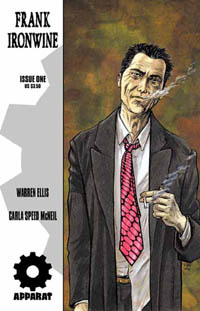 There are two simple, easy paths to win my heart, so pay attention. One path is piping hot General Tso’s over white rice, with a side of steamed dumplings followed by a slice of lemon meringue and two fingers of nicely aged scotch, neat. Number two is good, old fashioned police procedurals—where our detective is gruff, down-on-his-luck, and always a hair’s breath away from homelessness and alcohol poisoning, but it’s through his grit, wit and skill that he catches the killer.
There are two simple, easy paths to win my heart, so pay attention. One path is piping hot General Tso’s over white rice, with a side of steamed dumplings followed by a slice of lemon meringue and two fingers of nicely aged scotch, neat. Number two is good, old fashioned police procedurals—where our detective is gruff, down-on-his-luck, and always a hair’s breath away from homelessness and alcohol poisoning, but it’s through his grit, wit and skill that he catches the killer.
What can I say? I’m easy to please.
Warren Ellis doesn’t disappoint in his Frank Ironwine one-shot (and how great a name is that?). A part of his strange Apparat experiment—to offer a line of books, all as one-shots, presupposing what the comics industry could look like, if instead of a preponderance of super-heroes it paid its debt to other pulp genres. Ironwine is obviously his detective installment, and he plays the genre to the hilt. Let’s just say the opening shot of his title character in the dumpster had me at “hello.”
What is most striking at first about the issue is how much deft control Ellis exhibits over the issue. At no point does the story feel padded or truncated—every plot beat plays out at exactly the right pace and with excellent timing. After a humorous opening, with lots of Ellis patented witty banter between our titular hero and his new partner in the department, we’re quickly led to the crime scene and, much like an episode of Law and Order or any other nighttime police drama, we watch the detectives uncover the clues and see where they lead.
Since it’s a procedural, the mystery aspect of it doesn’t matter as much as watching Ironwine reason everything out. Most compelling about Ellis’s characterization, however, is the humanity he brings to the character—Ironwine is less interested in “catching the baddie” as he is with bringing some dignity and humanity to all the death surrounding him—even to the perpetrator.
Not to be outdone, his collaborator Carla Speed McNeil shows the same level of confidence and craftsmanship as in her own excellent book Finder. There’s a strange, gritty expressiveness to her work that somehow manages to straddle the line between cartoony and realistic, without feeling jarring or unexpected. Likewise her layouts and pacing are incredible, not relying on any unconventional angles to get the job.
Just simple comics, done right. It really makes me wish this series were ongoing… it’s that good. Definitely recommended.
FOUR OUT OF FIVE VIKINGS

“Avengers: Under Seige” is One of the Timeless Avenger Classics
By Devon Sanders
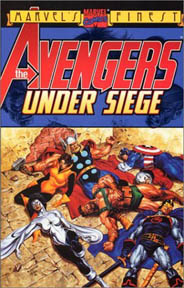 With Brian Michael Bendis taking the helm of Marvel’s New Avengers, it would be very easy to forget that anything else came before. It would be very easy but we at Thor’s Comic Column won’t let that happen to The Viking Faithful. Before Bendis, before Kurt Busiek’s Avengers run and sandwiched between two George Perez runs, there was the fondly remembered team of Roger (Amazing Spider-Man) Stern and the legendary John (Conan) Buscema. During their run, Spider-Man beat the cosmic snot out of Galactus’ herald, Firelord, Captain Marvel (Monica Rambeau) became The Avengers’ first Black female chairwoman, Sub-Mariner finally joined the ranks of The Avengers and while they were at it, even found the time to play a part in Jean Grey’s return to The Marvel Universe. Yet, no story is remembered with as much fondness as the Stern / Buscema magnum opus, Avengers: Under Siege. A moment in Avengers history garnering enough notice to bear mention in November’s Avengers: Finale as one of The Avengers finest moments. In fact, many, myself included, believe Avengers: Under Siege to simply be their finest moment, ever.
With Brian Michael Bendis taking the helm of Marvel’s New Avengers, it would be very easy to forget that anything else came before. It would be very easy but we at Thor’s Comic Column won’t let that happen to The Viking Faithful. Before Bendis, before Kurt Busiek’s Avengers run and sandwiched between two George Perez runs, there was the fondly remembered team of Roger (Amazing Spider-Man) Stern and the legendary John (Conan) Buscema. During their run, Spider-Man beat the cosmic snot out of Galactus’ herald, Firelord, Captain Marvel (Monica Rambeau) became The Avengers’ first Black female chairwoman, Sub-Mariner finally joined the ranks of The Avengers and while they were at it, even found the time to play a part in Jean Grey’s return to The Marvel Universe. Yet, no story is remembered with as much fondness as the Stern / Buscema magnum opus, Avengers: Under Siege. A moment in Avengers history garnering enough notice to bear mention in November’s Avengers: Finale as one of The Avengers finest moments. In fact, many, myself included, believe Avengers: Under Siege to simply be their finest moment, ever.
Captain America. Iron Man. Thor. The Wasp. Hawkeye. The Vision. The Scarlet Witch.
The Avengers ranks, when filled with these names, consistently, rose to whatever challenge put before them but time and needs being what they are, all of these names have left the group for one reason or another. No one ever question The Avengers mettle as long as these stalwarts were involved. Until Baron Zemo. With Thor away in Asgard, and the bulk of the Avengers mainstays, gone for other reasons, The Avengers have come to rely on The Wasp to chair a team composed of Captain America, Hercules, Captain Marvel and The Black Knight. With this largely untested team comprising the main Avengers roster, the time to strike is now. With a Masters of Evil team comprised of some of Marvel’s nastiest villains (Blackout, The Wrecking Crew, The Absorbing Man, Moonstone and Mr. Hyde, among others), Zemo attacks Avengers Mansion, fully knowing The Avengers loyal butler, Jarvis is the only soul there to protect its walls. The Avengers active roster is called in but quickly overwhelmed by the sheer numbers comprising these New Masters of Evil. With Hercules in a coma (following a beat-down from The Masters of Evil strongmen), a captured Captain America and Black Knight forced to watch the beating and torture of Jarvis and the disappearance of Captain Marvel, it’s left to The Wasp to send out anew, the call for help. Answering the call, a recently returned Thor, new Ant-Man Scott Lang, and Marvel D-lister, Doctor Druid. Will this small band be enough to defeat this new evil come to visit The Avengers? They are Avengers. As long as they draw breath, they will prevail, giving you one hell of a story in the process.
Writer Roger (Superman) Stern with Avengers: Under Siege, some eighteen years later, wrote a story that to this day, holds up. Stern puts The Avengers’ backs to the wall and proves, once and that The Avengers truly are Marvel’s premiere super team, no matter who makes up the roster. Stern turns The Avengers into more of an ideal, something one should strive for. A status to be obtained through force of will. The average reader will always wish to become a JLA member, Stern’s writing makes the reader believe through force of will one could become an Avenger.
John Buscema’s artwork is quite honestly, masterful. Every line laid down, every gesture combines to create something wonderful. Every panel is a clinic in anatomy coupled with layouts that simply amaze you with their simplicity. John Buscema was simply a treasure, one any fan of great art should take the time to learn from and enjoy. Tom Palmer’s inks combine with Buscema’s pencil to create the most flawless of artwork.
Avengers: Under Siege is the best comics has to offer with legacy and mastery of the comics medium is at play on every page. Avengers: Under Siege receives my highest possible recommendation.
FIVE OUT OF FIVE VIKINGS

Writer Joe Casey and his One Man “Infantry” May Have Lost the Battle, but Not the War
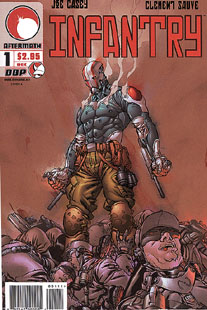 Wildcats. Deathlok. Mr. Majestic. Automatic Kafka.
Wildcats. Deathlok. Mr. Majestic. Automatic Kafka.
Most of you out there won’t give a damn about any of those four titles, but if you’re like me and have been a fan of writer Joe Casey’s work—particularly his under-the-radar titles like those mentioned—then hearing of some new project coming from him fills you just a little with Christmas spirit.
When I heard of Devil’s Due’s upcoming super-hero-maybe line, I was relatively under-enthused. Sure, I’ve enjoyed the names mentioned—Dixon, Waid, et cetera—but I’ve given most of their output a pass in the past, particularly with the disappointing “Shot Heard Round the World” eighties revival of the GI Joe titles. But then to hear Casey’s name attached to something new, well like I said, glee.
He starts in familiar Casey-Conspiracy-Thriller mode, with mysterious goings-on in the South Pacific being investigated by knowledgeable and smart men who are, probably, more than they say. Kudos to Casey for making the one of them, Mr. Alexander, an insurance adjuster—just a nice story detail that most other writers ignore.
The bulk of the issue, then, is spent with Mr. Alexander and his CIA handler at the wreckage site, intercut with the masked badass from the cover in a huge action scene. There’s also a running subplot of a costumed assassin whose look and introductory scene made me laugh out loud—Casey’s going for a cake-and-eat-it-too kind of situation. All of this counterpoint seems to overtly point to the two major threads being connected, and this will presumably be the uber-arch for the origin story to play out over the next few issues. Kind of, you know, a standard start.
Clement Suave’s art is rather compelling—I remember his name from a good chunk of Wildstorm’s aborted Stormwatch title, as well as some of that Human Defense Corps from DC a year or so ago. Suave has a fantastically kinetic style that lends itself well to the action sequences, and it’s here that the book really sings, but he also manages to stage the talking heads scenes without letting the issue fall flat.
While the action and the setup are quite intriguing—it’s sort of like the first half of a pretty fun pilot for a conspiracy thriller—there’s nothing terribly distinctive about any of it. I mean, by intercutting the fighting with the conversation in the Pacific, Casey is able to give dimension to the action while also lending portents and vitality to the conversation, but by the end of it all it seems to add up to not much just quite yet. I will come back for another issue or to, but I suspect that it’s more for Casey’s reliability and track-record than the content of the actual issue itself. Recommended with reservations.
TWO AND A HALF OUT OF FIVE VIKINGS

Pithy Headline About Subtext, Icebergs and the Tip Piercing the Surface of the “Ocean,” with Rewarding Depths Found Underneath
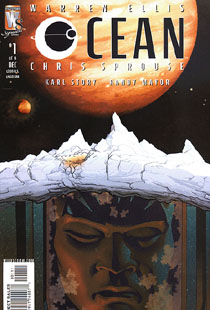 A merged review of Ocean # 1-3 should tell you something—first, it’s not a terribly episodic comic.
A merged review of Ocean # 1-3 should tell you something—first, it’s not a terribly episodic comic.
Now, it’d be easy for me to sit back and tell you that each installment is meager and lacking density, but when held together they all work well. It’d be common and standard to say that it feels ready-for-trade, and that you’d be better off picking it all up in one big chunk. In fact, supporting this theory is that the ending to # 1 and the beginning to # 2 are merely seconds apart—and it’s just the middle of a conversation that’s mostly setup.
All of that would be terribly easy, and we’ve all read reviews like that. And you know what? Yes, to some, I could see each of these issues being read monthly would gnaw on the nerves because of the more leisurely pacing. And yes, I’d even concede that Warren Ellis intended a story under one cover, and the seri